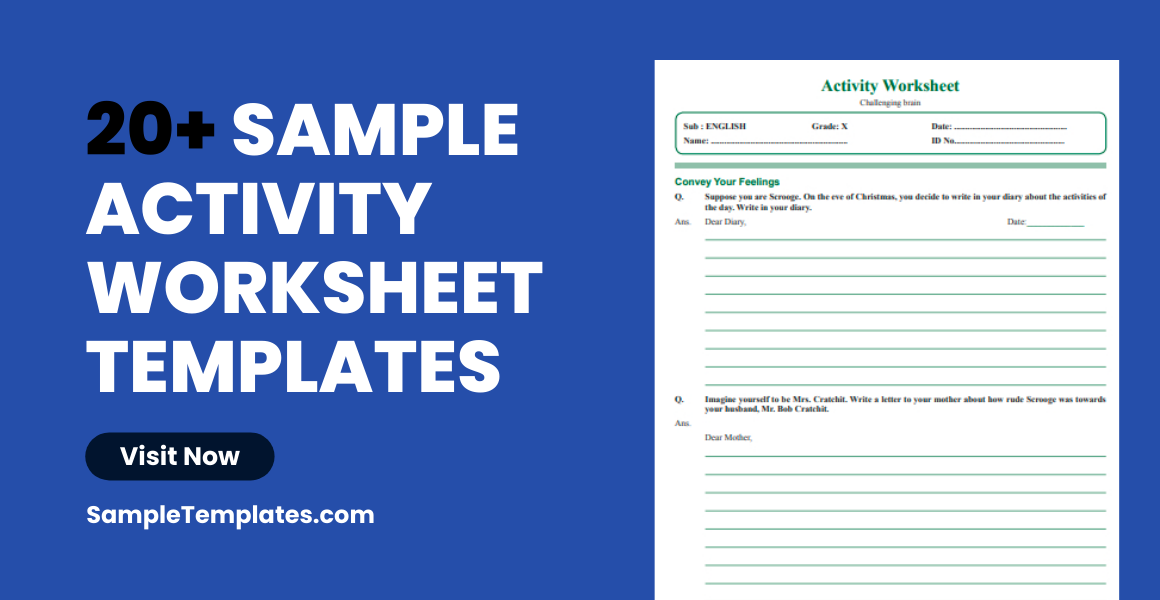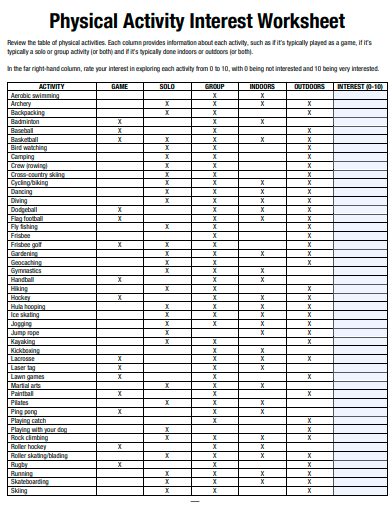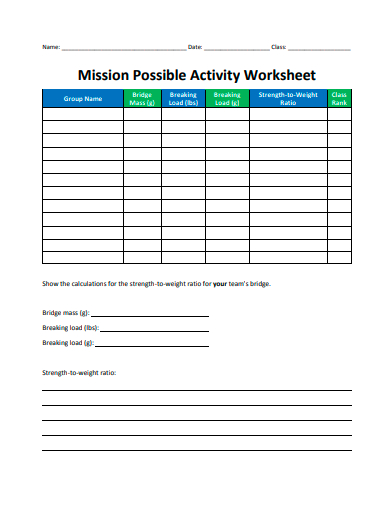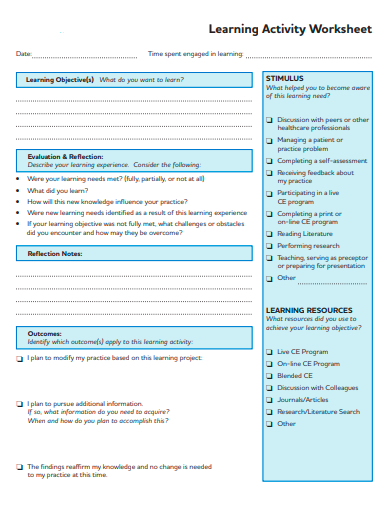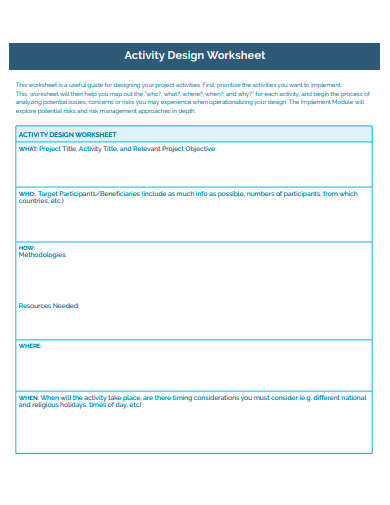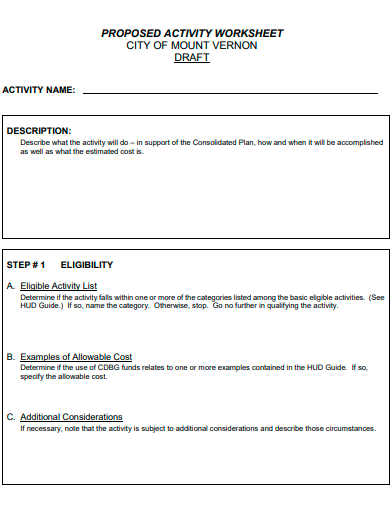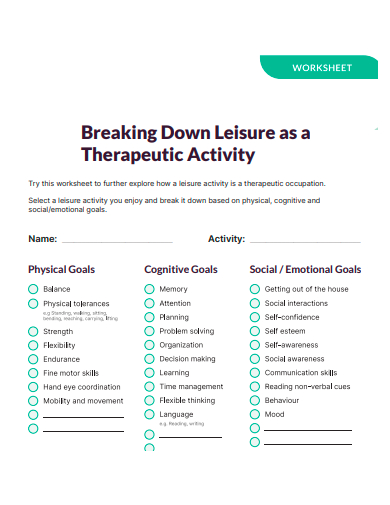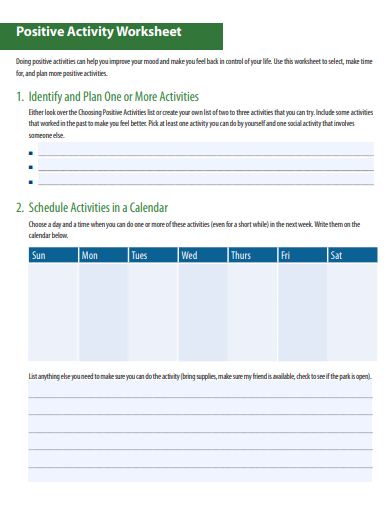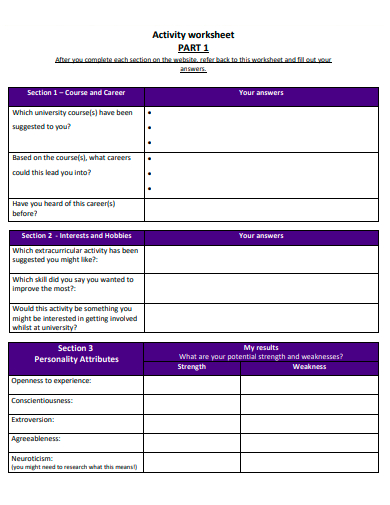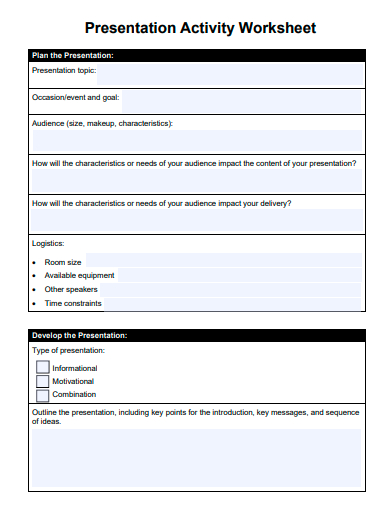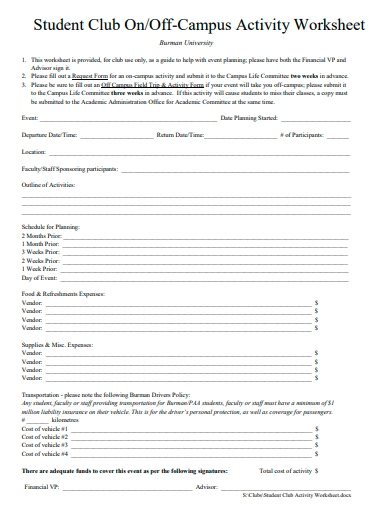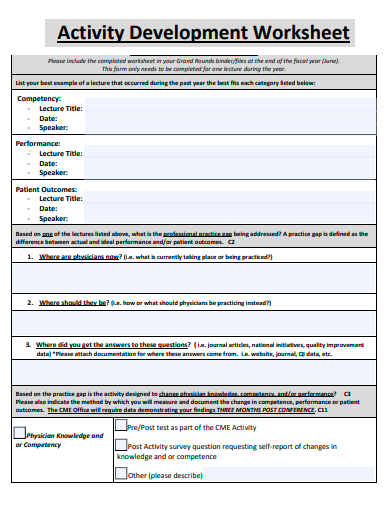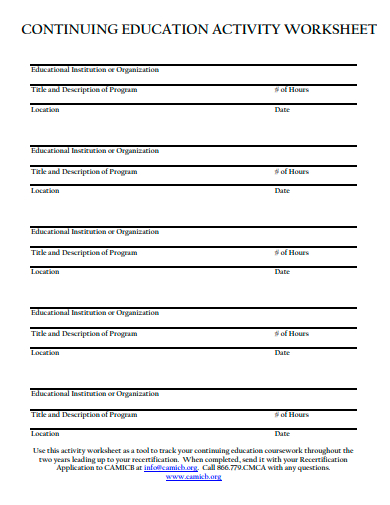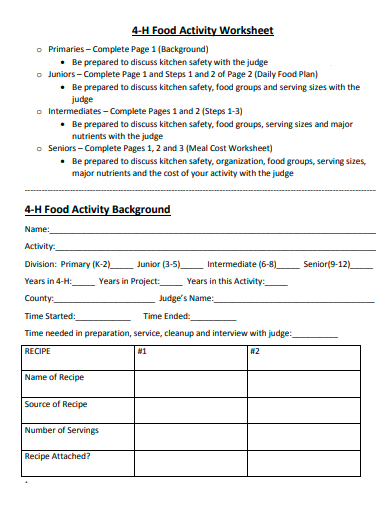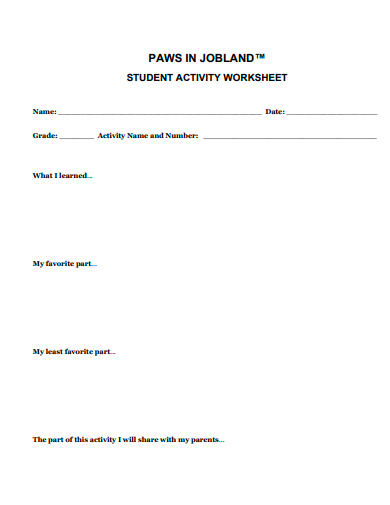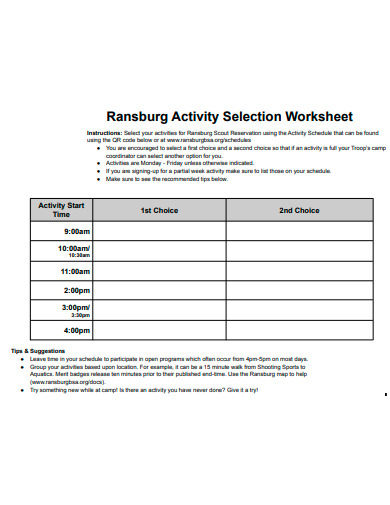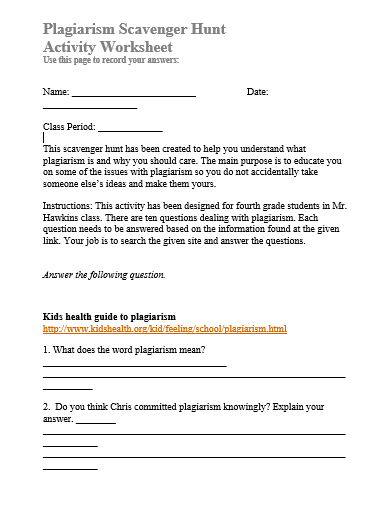Discover the power of structured learning with our Sample Activity Worksheet Template. Specifically crafted to enrich cognitive skills, this template seamlessly combines education with engagement. Whether you’re an educator seeking innovative resources or a learner hungry for fresh challenges, this sample worksheet stands as a testament to modern, effective learning strategies. Dive in and experience a transformative way to educate, all while harnessing the core essence of interactive skill-building. Your ultimate tool for educational excellence awaits!
20+ Activity Worksheet Samples
1. Activity Planning Worksheet Template
2. Sample Physical Activity Interest Worksheet Template
3. Mission Possible Activity Worksheet Template
4. Learning Activity Worksheet Template
5. Activity Design Worksheet Template
An Activity Worksheet: An In-Depth Look
An activity worksheet, at its core, is an educational tool a tangible or digital document composed of a series of tasks or exercises meticulously designed to enhance and support learning in a specific subject or skill domain. It is a bridge between theoretical knowledge and practical application, providing a structured platform for students to engage, explore, and evaluate their understanding of the topics they study.
Historical Perspective
Historically, the concept of worksheets can be traced back to the days of early education when slate boards were used to practice writing and arithmetic. As education evolved and the need for standardized methods of teaching emerged, printed worksheets became a staple in classrooms worldwide. Today, in our digital age, worksheets have adapted once again, taking the form of interactive online assignments or downloadable PDFs, making them more versatile and accessible.
Purpose and Benefits
Reinforcement: Activity worksheets often follow lessons, ensuring that the student has grasped the main concepts. They serve as a reinforcing tool, helping students internalize what they’ve been taught.
Assessment: Teachers frequently use worksheets to assess a student’s understanding of a topic. The feedback from these assessments can guide future lessons and indicate areas needing further attention.
Skill Practice: Repetition is a key component of skill acquisition. Worksheets offer students the opportunity to practice a skill multiple times, leading to mastery.
Engagement: Well-designed worksheets can be interactive and fun. Puzzles, crosswords, and coloring activities can make learning enjoyable and memorable.
Organization: They provide a structured framework, guiding students step by step through a particular topic, ensuring all essential points are covered.
Types of Activity Worksheets
While the design and nature of worksheets can vary based on age group and subject, some common types include:
Fill-in-the-Blanks: These test a student’s recall and understanding of specific terms or concepts.
Multiple Choice and True/False: Often used in quizzes, these gauge comprehension and can be graded quickly.
Math Problems: These allow students to practice arithmetic, algebra, geometry, and more.
Reading Comprehension: After reading a passage, students answer questions to demonstrate their understanding.
Essay Prompts: These allow for extended responses, assessing a student’s ability to articulate thoughts on a topic.
Interactive Worksheets: Often digital, these can include clickable options, drag-and-drop activities, and multimedia elements.
The Digital Evolution
In the 21st century, the digital revolution has greatly influenced the design and delivery of activity worksheets. Online platforms now offer interactive worksheets that provide instant feedback, adjust the level of difficulty based on student performance, and incorporate multimedia elements to cater to diverse learning styles. These advancements not only make learning more engaging but also allow for personalization, ensuring that each student’s unique needs are addressed.
Activity worksheets, whether traditional paper-based or digital, remain an integral component of the educational process. Their adaptability, ranging from primary school coloring tasks to advanced college-level problem-solving exercises, attests to their utility in fostering a deep and enduring understanding of subjects. As educational methodologies continue to evolve, it’s certain that the humble activity worksheet will continue to adapt, offering innovative ways to engage and educate future generations.
6. Account Activity Worksheet Template
7. Sample Proposed Activity Worksheet Template
8. Therapeutic Activity Worksheet Template
9. Positive Activity Worksheet Template
10. Sample Activity Worksheet Template
11. Presentation Activity Worksheet Template
12. Off-Campus Activity Worksheet Template
How do I create an activity worksheet?
Creating an activity worksheet involves a combination of pedagogical understanding, creativity, and clarity. Whether you’re a teacher designing for a classroom, a parent creating activities for your child, or a professional developing content for wider distribution, the principles remain largely consistent. Here’s a step-by-step guide to help you craft an effective activity worksheet:
Define Your Objective
Before you begin, determine what you want the student to learn or practice through this worksheet. Is it to reinforce a concept taught in class? Is it to test their understanding? Or is it simply for fun and enrichment?
Know Your Audience
Understanding the age group and proficiency level of your audience is essential. Worksheets for younger children might involve more images, coloring activities, and simpler questions, whereas older students may benefit from more complex tasks and open-ended questions.
Choose the Worksheet Format
Depending on your objective, decide on the format:
Fill-in-the-Blanks: To recall facts or vocabulary.
Multiple Choice: For quick assessment of comprehension.
Matching: To link related items.
Short Answer or Essays: For in-depth understanding.
Puzzles and Crosswords: For vocabulary review or fun challenges.
Diagrams or Charts: For labeling or categorizing.
Design with Clarity
Ensure that instructions are clear. Use legible fonts and provide ample space for students to write their answers. If it’s a printed worksheet, ensure that lines or boxes are clearly visible.
Make It Engaging
Utilize images, graphics, and creative scenarios to make the worksheet more interactive and less monotonous. This is especially crucial for younger students who are more visually oriented.
Include a Variety
Instead of sticking to one type of question, mix it up. A combination of multiple-choice questions, short answers, and interactive tasks can cater to different learning styles.
Provide an Answer Key
Especially if the worksheet is meant for independent learning, it’s helpful to provide an answer key. This allows students (or parents) to check their work.
Test Your Worksheet
Before finalizing, give your worksheet to a few students or peers for feedback. This can help you identify confusing instructions or errors.
Consider Digital Tools
There are various online platforms and software like Google Forms, Microsoft Word, Canva, or specialized educational tools that can assist you in creating professional-looking and interactive worksheets.
Review and Revise
As with any educational content, it’s crucial to periodically review and update your worksheets. As curricula change, or as you receive feedback from students, you’ll want to ensure that your worksheets remain relevant and effective.
Creating an activity worksheet is both an art and a science. While the content should align with educational objectives, the presentation should engage and motivate the learner. Remember, the ultimate goal is not just to fill out a sheet, but to enhance understanding and foster a love for learning.
13. Printable Activity Worksheet Template
14. Activity Development Worksheet Template
15. Continuing Education Activity Worksheet Template
16. Sample Regular Activity Worksheet Template
17. Action Team Activity Worksheet Template
18. Food Activity Worksheet Template
19. Student Activity Worksheet Template
20. Activity Selection Worksheet Template
21. Activity Worksheet in DOC
How to Do Activity Worksheet: 6 Tips
Successfully completing an activity worksheet requires focus, comprehension, and an organized approach. Whether you’re a student aiming for high marks or an individual seeking to make the most of learning materials, the following tips can help you effectively tackle any activity worksheet:
Skim and Scan
Before diving in, take a moment to skim through the entire worksheet. This initial overview helps you:
Understand the worksheet’s structure.
Identify the types of questions or tasks you’ll encounter.
Estimate the time you might need to allocate to different sections.
Carefully Read Instructions
Misinterpreting instructions can lead to avoidable mistakes. Spend a few extra seconds reading and comprehending the directions for each section or question. If something seems unclear, read it again or seek clarification.
Prioritize Your Approach
Not all questions or tasks are created equal. Some may take longer, while others can be answered quickly. Decide whether you want to tackle the easier or more familiar questions first to gain momentum or dive into the challenging sections while your mind is fresh. Organize your approach based on your strengths and the time available.
Use All Available Resources
If permitted, make use of textbooks, notes, or online resources. Activity worksheets, especially for homework or practice, often allow for reference materials. Efficiently using these resources can not only provide answers but also reinforce learning by revisiting concepts.
Review as You Go
After completing each section, take a moment to review. Ensure that you haven’t missed any questions or made any glaring errors. Regular reviews can prevent accumulation of mistakes and give you confidence as you progress through the worksheet.
Maintain Neatness and Organization
Presenting your answers clearly can make a world of difference. For written answers, ensure your handwriting is legible. For digital worksheets, make sure you’ve filled in the required fields correctly. Neatness can assist in easy reviewing and can also make a positive impression if the worksheet is being graded.
Tackling an activity worksheet effectively is a combination of comprehension, strategy, and diligence. With these six tips, you’ll not only find the process smoother but will also maximize the learning potential that worksheets offer. Remember, it’s not just about getting to the end, but understanding and absorbing the content along the way.
Related Posts
FREE 20+ Goal Setting Worksheet Samples in MS Word | Google Docs | Pages | Excel | Google Sheets | Numbers | PPT | PDF
FREE 30+ Cost Worksheet Samples in Google Docs | Google Sheets | MS Excel | MS Word | Apple Numbers | Apple Pages | PDF
FREE 50+ Assessment Worksheet Samples in PDF | MS Word
FREE 25+ Campaign Worksheet Samples in PDF
FREE 50+ Application Worksheet Samples in PDF | MS Word
FREE 10+ Distribution Worksheet Samples in PDF
FREE 10+ Family Worksheet Samples in PDF
FREE 10+ Personal Worksheet Samples in PDF
FREE 7+ Depreciation Worksheet Samples & Templates in PDF | MS Word
FREE 10+ Typing Worksheets Samples in PDF | DOC
FREE 10+ Maths Worksheets Samples in PDF | DOC
FREE 10+ 4th grade Worksheets Samples in PDF
FREE 10+ Weekly Budget Worksheet Samples in MS Word | MS Excel | Google Docs | Google Sheets | PDF
FREE 10+ Expense Worksheet Samples in PDF
FREE 10+ Investment Worksheet Samples in PDF
